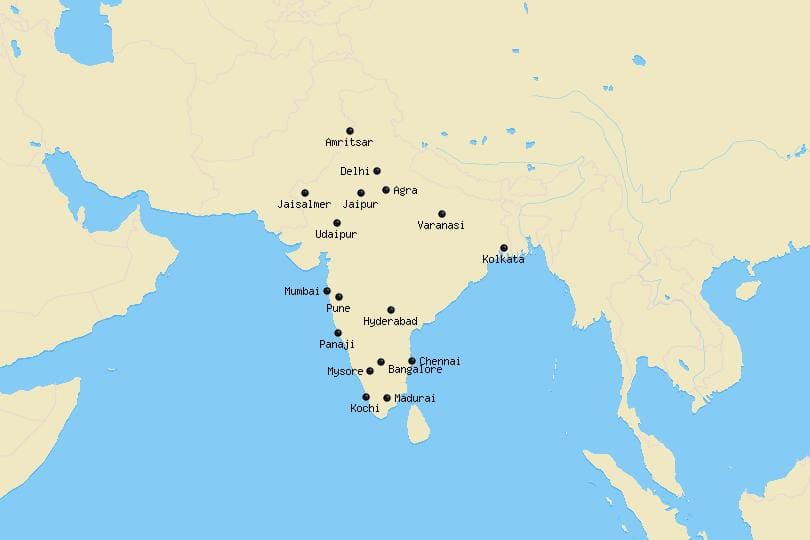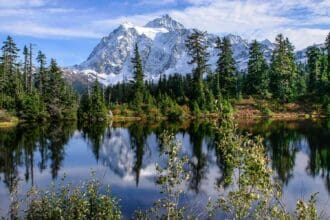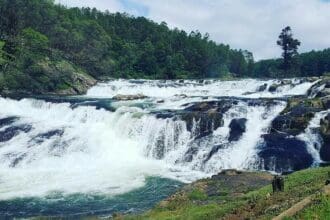Jim Corbett National Park, nestled in the foothills of the Himalayas, is a captivating wildlife sanctuary that offers a unique and exhilarating experience for nature enthusiasts and wildlife lovers. This renowned national park, located in the state of Uttarakhand, India, is named after the legendary British hunter-turned-conservationist, Jim Corbett. Spanning across an area of approximately 520 square kilometers, the park is not only celebrated for its diverse flora and fauna but also for being the oldest national park in India. Let’s delve deeper into the wonders that await in this wildlife extravaganza.
1. Introduction
Jim Corbett National Park, established in 1936, holds the distinction of being India’s first national park and a significant milestone in the conservation movement of the country. The park’s primary objective is to protect the endangered Bengal tigers and their natural habitat, making it a crucial stronghold for tiger conservation in India. However, it is not just the majestic tigers that call this park home; it boasts a remarkable range of biodiversity, making it a haven for wildlife enthusiasts.
2. History of Jim Corbett National Park
The history of Jim Corbett National Park can be traced back to the early 20th century when it was known as Hailey National Park, named after Sir Malcolm Hailey, the Governor of the United Provinces. Later, in 1957, the park was renamed Jim Corbett National Park in honor of the renowned hunter and conservationist, Jim Corbett, who played a vital role in establishing the park and advocating for wildlife conservation in India.
3. Location and Geographical Features
Jim Corbett National Park is situated in the Nainital district of Uttarakhand, a picturesque region known for its pristine natural beauty. The park is nestled in the Shivalik hills of the Himalayan foothills and is spread across three distinct zones: the Bijrani Zone, the Dhikala Zone, and the Jhirna Zone. Each zone offers a unique landscape and wildlife viewing experience, with lush forests, sparkling rivers, and mesmerizing vistas.
4. Flora and Fauna
Jim Corbett National Park is renowned for its remarkable biodiversity, housing a wide array of flora and fauna. The park is characterized by its diverse forest types, including Sal forests, mixed deciduous forests, and grasslands. This varied habitat provides a haven for numerous animal species, including the iconic Bengal tiger, Indian elephants, leopards, sloth bears, and over 600 species of birds.
The park’s flagship species, the Bengal tiger, attracts wildlife enthusiasts from all around the world. However, the park is not just about tigers; it is home to other charismatic species such as the Indian elephant, leopard, Himalayan black bear, golden jackal, and several species of deer. The avian population is equally impressive, with species like the crested serpent eagle, great hornbill, and red junglefowl adding to the park’s charm.
5. Safari Experience
Exploring the wilderness of Jim Corbett National Park is an adventure like no other. The park offers a range of safari experiences that allow visitors to get up close and personal with the enchanting wildlife.
a. Different safari zones
The park is divided into several zones, each offering a unique experience. The Bijrani Zone, known for its picturesque landscapes and abundant wildlife, is a favorite among visitors. The Dhikala Zone, situated in the heart of the park, is famous for its grasslands and provides an excellent opportunity to spot tigers and elephants. The Jhirna Zone, on the other hand, is known for its diverse birdlife.
b. Jeep safari
Jeep safaris are the most popular way to explore the park. Accompanied by experienced guides, visitors can traverse the rugged terrain, weaving through dense forests and open grasslands. Jeep safaris offer a thrilling and immersive experience, allowing visitors to witness the park’s wildlife in their natural habitat.
c. Elephant safari
For a truly unique and awe-inspiring experience, visitors can opt for an elephant safari. Sitting atop these gentle giants, one can traverse the park’s trails while enjoying a vantage point that offers a different perspective on the surrounding landscape. Elephant safaris are particularly popular for tiger tracking and birdwatching.
6. Accommodation Options
Jim Corbett National Park offers a range of accommodation options to suit different preferences and budgets. From luxurious resorts to cozy forest rest houses, visitors can choose the type of accommodation that best complements their wildlife adventure.
a. Resorts and lodges
Several resorts and lodges are situated in the vicinity of the park, offering comfortable and luxurious stays. These establishments provide modern amenities, exquisite dining options, and often organize nature walks and cultural performances to enhance the overall experience.
b. Forest rest houses
For a more immersive and adventurous stay, forest rest houses within the park premises are a popular choice. These rest houses allow visitors to be closer to nature and offer a rustic charm. Prior reservations are required, and it is advisable to book well in advance due to limited availability.
7. Conservation Efforts
Jim Corbett National Park has played a crucial role in the conservation of the Bengal tiger and other endangered species. The park’s management focuses on maintaining the delicate balance between wildlife conservation and ecotourism. Efforts are made to curb poaching, preserve the park’s habitat, and create awareness about the importance of wildlife conservation among visitors.
8. Best Time to Visit
The best time to visit Jim Corbett National Park is during the winter months of November to February when the weather is pleasant, and the chances of wildlife sightings are higher. The park remains closed during the monsoon season from June to October due to heavy rainfall, and the summer months from March to May can be scorching hot.
9. Things to Do
Apart from wildlife safaris, Jim Corbett National Park offers a plethora of activities for nature enthusiasts and adventure seekers.
a. Wildlife photography
With its stunning landscapes and diverse wildlife, Jim Corbett National Park is a paradise for wildlife photographers. The park’s charismatic animals, vibrant birdlife, and breathtaking vistas provide ample opportunities to capture mesmerizing moments in the lens.
b. Birdwatching
The park is a haven for birdwatchers, with over 600 species of birds recorded. From migratory birds to endemic species, birdwatching in Jim Corbett National Park offers an unmatched experience for avian enthusiasts.
c. Nature walks
Exploring the park on foot through guided nature walks is a fantastic way to soak in the tranquility of the surroundings. Trained naturalists accompany visitors, offering insights into the park’s flora, fauna, and ecological significance.
d. Trekking
For those seeking an adrenaline rush, trekking in the surrounding hills and forests is a popular activity. There are several trails of varying difficulty levels, offering opportunities to explore the wilderness and enjoy panoramic views of the Himalayas.
10. Nearby Attractions
Jim Corbett National Park is surrounded by several attractions that are worth exploring.
One such attraction is the Corbett Museum, located in the Kaladhungi area, which was once Jim Corbett’s home. The museum showcases his life and contributions to wildlife conservation through photographs, artifacts, and manuscripts.
Another popular nearby destination is the Garjiya Devi Temple, perched on a hillock near the Kosi River. This temple holds religious significance and offers stunning views of the surrounding landscape.
11. Safety Tips
While visiting Jim Corbett National Park, it is essential to prioritize safety and adhere to the guidelines provided by the park authorities. Some important safety tips include:
- Always follow the instructions of the safari guide or naturalist.
- Maintain a safe distance from wildlife and refrain from disturbing them.
- Do not litter and help keep the park clean.
- Respect the natural habitat and avoid causing any harm to the flora and fauna.
- Carry necessary medications and follow safety protocols, especially during the ongoing COVID-19 pandemic.
12. Responsible Tourism
Responsible tourism is vital to ensure the long-term sustainability of Jim Corbett National Park. As a responsible visitor, it is important to:
- Respect the park’s rules and regulations.
- Avoid making excessive noise that may disturb wildlife.
- Refrain from feeding or touching animals.
- Support local communities and businesses that promote sustainable practices.
- Contribute to the conservation efforts of the park through donations or volunteering.
13. Conclusion
Jim Corbett National Park stands as a testament to the beauty and diversity of India’s wildlife. From the regal Bengal tigers to the melodious chirping of birds, the park offers a surreal experience for nature enthusiasts. With its rich history, stunning landscapes, and remarkable wildlife, it continues to attract visitors from across the globe. A visit to this wildlife extravaganza is sure to leave an indelible mark on one’s soul, fostering a deeper appreciation for the wonders of the natural world.
14. FAQs
1. How do I book a safari in Jim Corbett National Park? Booking a safari in Jim Corbett National Park can be done online through the official website of the park or through authorized tour operators. It is advisable to book in advance to secure your preferred safari zone and timing.
2. Can I spot tigers in the park? Yes, Jim Corbett National Park is known for its tiger population. While tiger sightings are not guaranteed, the park offers a good chance of spotting these majestic creatures in their natural habitat.
3. Are there any restrictions on photography? Photography is allowed in the park, but there are certain restrictions to ensure the safety of wildlife. It is advised to follow the guidelines provided by the safari guide or naturalist regarding photography.
4. Is it safe to visit the park with children? Yes, it is safe to visit Jim Corbett National Park with children. However, it is important to ensure their safety by adhering to the park’s guidelines and keeping a safe distance from wildlife.
5. Are there any medical facilities available in the park? Yes, there are medical facilities available in the park. The park administration has a dedicated medical unit to address any emergencies. It is advisable to carry basic medications and consult a doctor before your visit.


















